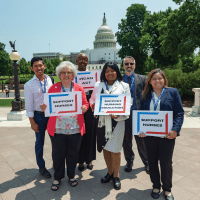Statement acknowledges harms to nurses of color, outlines actions for change.
Editor’s note: This is an early release of an article that will appear in the August 2022 issue of American Nurse Journal.
“This is a journey.”
So starts the American Nurses Association (ANA) Racial Reckoning Statement, which the ANA Membership Assembly—the governing and official voting body of ANA—approved by unanimous consent at its June 2022 meeting in Washington, DC. This seven-page document, submitted by the ANA Board of Directors, sets the course for the association to embark on a continual process of not only reckoning with harmful practices and policies but also apologizing to, seeking reconciliation with and forgiveness from nurses of color, and healing of individual nurses and our profession. (nursingworld.org/RacialReckoningStatement)
This document also sets the stage for ANA to not only grapple with its shortcomings but also make both the association and the profession stronger and more impactful. The statement and the actions we take now and in the future will give ANA the opportunity to model antiracist practices and policies for other members of the healthcare team. Collectively, these efforts will further our vision of a healthy world through the power of nursing.
So why was this statement necessary, and why now? ANA didn’t undertake this work because diversity, equity, and inclusion are fashionable in 2022. Rather, we see it as a pivotal moment to live up to our Code of Ethics and listen carefully to nurses of color—a term that reflects all nurses representing racial and ethnic groups. The statement also opens a space for long-overdue dialogue and positive change.
The efforts of the National Commission to Address Racism in Nursing, in which ANA participates along with three co-leading and 20 member organizations, have made clear the pain and persistent harms nurses of color have endured and continue to experience. This work, though separate from ANA’s self-examination, informs our reckoning and reconciliation journey.
As the statement describes, the association, over its 126-year history, sometimes acted and at other times failed to act in ways that perpetuated racism and harmed nurses of color. For example, membership eligibility changed in 1916 from alumnae-based to state- and district-based, which effectively denied many Black nurses membership. This discrimination persisted for decades, even after the ANA House of Delegates created an individual membership category in 1948. ANA leaders failed over this extended period to pursue truly inclusive state-level membership. When the association membership rules finally became nondiscriminatory, ANA still didn’t encourage full participation by nurses of color. Not to put too fine a point on it, but I’m just the third nurse of color and first man to serve as ANA president.
The Racial Reckoning Statement also outlines how ANA approved a position paper in 1965 that recommended a baccalaureate degree as the minimum preparation for entry into practice. This position disenfranchised educational programs that were predominantly available to students of color and excluded their graduates. Having set a higher standard for the profession, ANA subsequently failed to ensure that all nurses would have the same access to this desired norm. The ripple effects of this persist even now. In failing nurses of color, the association also failed to support care for communities of color.
The statement doesn’t just look back; it also contemplates antiracist, inclusive efforts the Board of Directors and ANA pledge to undertake. For instance, the Board of Directors commits to engage in direct reconciliation with ethnic-minority nursing associations. ANA also commits to building diversity within its volunteer and governance structure.
These actions and others to come mark milestones in our journey to strengthen the association and our profession. We welcome all nurses to join with us in achieving the best possible future for nursing and the nation’s health.

Ernest J. Grant, PhD, RN, FAAN
President, American Nurses Association



















2 Comments. Leave new
My heart is filled with joy to know that nurses of color will no longer be penalized but recognized for their commitment to excellence.
In 1959 I was a mouthy but naive farm girl and a freshman student at the Missouri Baptist Hospital School of Nursing. I asked my director of nursing why we did not have any Black student nurses. She said, ” We would not have any place to house them.” We were in an area of St Louis that was predominately Black. We had Black workers in the kitchen, but I only remember one Black RN employee. She was pregnant and went into premature labor. She had a C-Section and became post operatively our first Black Patient, Early Gardner RN since 1962